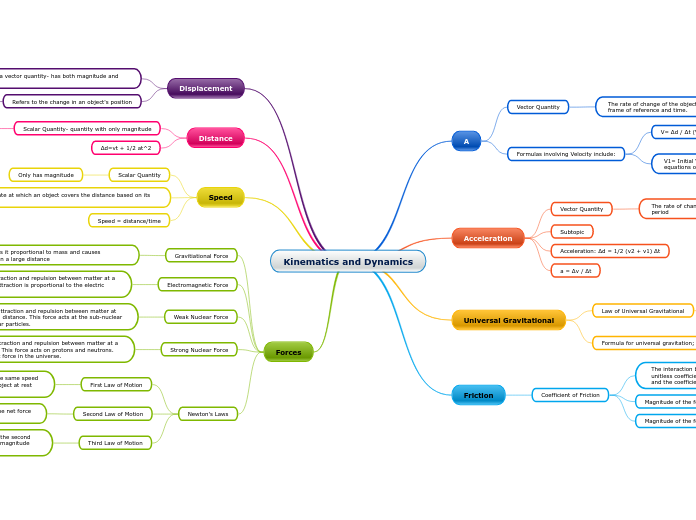Kinematics and Dynamics
Type in the name of the company you are going to have an interview with.
Forces
Newton's Laws
Third Law of Motion
When an object exerts a force on another object, the second body exerts a force on the first body of the same magnitude but in the opposite direction.
Fab = - Fba
Second Law of Motion
The acceleration of the object depends based on the net force applied and inversely to the mass of an object
F = ma
First Law of Motion
An object at motion tends to stay in motion at the same speed and direction unless acted upon by a force. An object at rest stays at rest.
Net Force: Fnet= F1 + F2 + F3 ...
Strong Nuclear Force
This force causes attraction and repulsion between matter at a very small distance. This force acts on protons and neutrons. This is the strongest force in the universe.
Weak Nuclear Force
This force causes attraction and repulsion between matter at an extremely small distance. This force acts at the sub-nuclear level on sub-nuclear particles.
Electromagnetic Force
How would you describe yourself?
Type in a short description.
This force causes attraction and repulsion between matter at a large distance. The attraction is proportional to the electric charge.
Gravitiational Force
What are your hobbies?
What do you like to do in your free time? What was the last film you saw or the last book you read? Think of the activities that relax you the most. Fill in several hobbies.
The force where is it proportional to mass and causes attraction between a large distance
Speed
How ambitious are you?
Speed = distance/time
The rate at which an object covers the distance based on its unit
Where and how do you see yourself in 5 years time?
Type in the answers.
Examples: m/s, km/h, etc.
Scalar Quantity
What are your long-term goals ?
Type them in.
Only has magnitude
Distance
Δd=vt + 1/2 at^2
Scalar Quantity- quantity with only magnitude
Why will/did you leave your existing/last job?
The total length of the path traveled by an object in motion
Typically represented in m, km, etc.
Displacement
Do you fully understand what this position implies?
After you've made some research on the company, read the job description thoroughly, and try to fully understand what your responsibilities will be.
Refers to the change in an object's position
What do you think the main challenges will be?
Type them in.
Δd= Final displacement - initial displacement
Displacement is a vector quantity- has both magnitude and direction
What will be your main tasks?
Type them in.
Direction is represented in terms of direction in square brackets, [N], [S], [E], [W].
Friction
Coefficient of Friction
Magnitude of the force of Kinetic Friction
FK = mKFN
Magnitude of the force of Static Friction
FS = mSFN
The interaction between two surfaces is quantified with unitless coefficients called the coefficient of static friction (mS) and the coefficient of kinetic friction (mK).
Universal Gravitational
Formula for universal gravitation; Fg=Gm1m2/d ^2
Law of Universal Gravitational
There exists a force of gravitational attraction between every two objects in the universe. This force varies inversely as the square of the distance between the objects and directly as the product of their masses. The force's direction is towards the centre of the attracting object.
Acceleration
Are you qualified for this position?
Interviewers will want to know whether or not you are able to do the job.
Answer the questions from this section and see if you are the right person for this position.
a = Δv / Δt
Acceleration: Δd = 1/2 (v2 + v1) Δt
Subtopic
What are your weaknesses?
Examples:
stubbornoverly critical, can't accept authoritytoo demandingtoo talkativetoo quiettoo sensitivelacking assertivenesslacking social tact
The rate of change in speed/velocity over the given time period
A
Research the company
You should find and learn as much as you can about the company where you are having an interview.
The interviewer will want to see what you know about them and why you chose the company.
Doing your homework will show that you are really interested.
Formulas involving Velocity include:
What do you know about the company's main goal and vision?
Type in the answer.
V1= Initial Velocity, V2= Final Velocity, part of the five equations of kinematics
v2^2 = V1^2 + 2 aΔd
V2 = v1 + aΔt
V= Δd / Δt (Velocity formula/uniform motion)
Vector Quantity
What can you do for this company that someone else can't?
Type in several unique traits that will turn you into the perfect candidate for the position.
The rate of change of the object's position with respect to a frame of reference and time.









